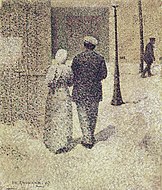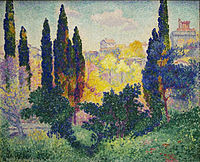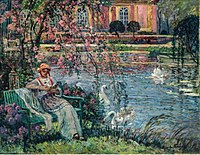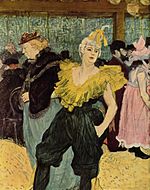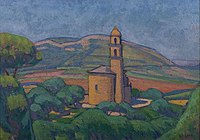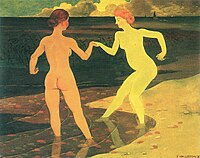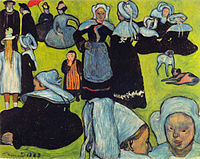Post-Impressionism


Post-Impressionism(also spelledPostimpressionism) was a predominantly Frenchart movementthat developed roughly between 1886 and 1905, from the lastImpressionistexhibition to the birth ofFauvism.Post-Impressionism emerged as a reaction against Impressionists' concern for the naturalistic depiction of light and colour. Its broad emphasis on abstract qualities or symbolic content means Post-Impressionism encompassesLes Nabis,Neo-Impressionism,Symbolism,Cloisonnism,thePont-Aven School,andSynthetism,along with some later Impressionists' work. The movement's principal artists werePaul Cézanne(known as the father of Post-Impressionism),Paul Gauguin,Vincent van GoghandGeorges Seurat.[1]
The term Post-Impressionism was first used by art criticRoger Fryin 1906.[2][3]CriticFrank Rutterin a review of theSalon d'Automnepublished inArt News,15 October 1910, describedOthon Frieszas a "post-impressionist leader"; there was also an advert for the showThe Post-Impressionists of France.[4]Three weeks later, Roger Fry used the term again when he organised the 1910 exhibitionManet and the Post-Impressionists,defining it as the development of French art sinceÉdouard Manet.
Post-Impressionists extendedImpressionismwhile rejecting its limitations: they continued using vivid colours, sometimes usingimpasto(thick application of paint) and painting from life, but were more inclined to emphasize geometric forms, distort form for expressive effect, and use unnatural or modified colour.
Overview[edit]
The Post-Impressionists were dissatisfied with what they felt was the triviality of subject matter and the loss of structure in Impressionist paintings, though they did not agree on the way forward.Georges Seuratand his followers concerned themselves withpointillism,the systematic use of tiny dots of colour.Paul Cézanneset out to restore a sense of order and structure to painting, to "make of Impressionism something solid and durable, like the art of the museums".[5]He achieved this by reducing objects to their basic shapes while retaining the saturated colours of Impressionism. The ImpressionistCamille Pissarroexperimented withNeo-Impressionistideas between the mid-1880s and the early 1890s. Discontented with what he referred to as romantic Impressionism, he investigatedpointillism,which he called scientific Impressionism, before returning to a purerImpressionismin the last decade of his life.[6]Vincent van Goghoften used vibrant colour and conspicuous brushstrokes to convey his feelings and his state of mind.
Although they often exhibited together, Post-Impressionist artists were not in agreement concerning a cohesive movement. Yet, the abstract concerns of harmony and structural arrangement, in the work of all these artists, took precedence overnaturalism.Artists such as Seurat adopted a meticulously scientific approach to colour and composition.[7]
Defining Post-Impressionism[edit]
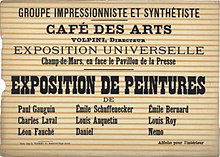

The term was used in 1906,[2][3]and again in 1910 byRoger Fryin the title of an exhibition of modern French painters:Manet and the Post-Impressionists,organized by Fry for theGrafton Galleriesin London.[7][8]Three weeks before Fry's show, art criticFrank Rutterhad put the termPost-Impressionistin print inArt Newsof 15 October 1910, during a review of theSalon d'Automne,where he describedOthon Frieszas a "post-impressionist leader"; there was also an advert in the journal for the showThe Post-Impressionists of France.[4]
Most of the artists in Fry's exhibition were younger than the Impressionists. Fry later explained: "For purposes of convenience, it was necessary to give these artists a name, and I chose, as being the vaguest and most non-committal, the name of Post-Impressionism. This merely stated their position in time relatively to the Impressionist movement."[9]John Rewaldlimited the scope to the years between 1886 and 1892 in his pioneering publication onPost-Impressionism: From Van Gogh to Gauguin(1956). Rewald considered this a continuation of his 1946 study,History of Impressionism,and pointed out that a "subsequent volume dedicated to the second half of the post-impressionist period":[10]Post-Impressionism: From Gauguin to Matisse,was to follow. This volume would extend the period covered to other artistic movements derived from Impressionism, though confined to the late 19th and early 20th centuries. Rewald focused on such outstanding early Post-Impressionists active in France asvan Gogh,Gauguin,Seurat,andRedon.He explored their relationships as well as the artistic circles they frequented (or were in opposition to), including:
- Neo-Impressionism:ridiculed by contemporary art critics as well as artists asPointillism;SeuratandSignacwould have preferred other terms:Divisionismfor example
- Cloisonnism:a short-lived term introduced in 1888 by the art criticÉdouard Dujardin,was to promote the work ofLouis Anquetin,and was later also applied to contemporary works of his friendÉmile Bernard
- Synthetism:another short-lived term coined in 1889 to distinguish recent works of Gauguin and Bernard from that of more traditional Impressionists exhibiting with them at theCafé Volpini.
- Pont-Aven School:implying little more than that the artists involved had been working for a while in Pont-Aven or elsewhere in Brittany.
- Symbolism:a term highly welcomed by vanguard critics in 1891, when Gauguin dropped Synthetism as soon as he was acclaimed to be the leader of Symbolism in painting.
Furthermore, in his introduction to Post-Impressionism, Rewald opted for a second volume featuringToulouse-Lautrec,Henri Rousseau"le Douanier",Les NabisandCézanneas well as theFauves,the youngPicassoand Gauguin's last trip to theSouth Seas;it was to expand the period covered at least into the first decade of the 20th century—yet this second volume remained unfinished.
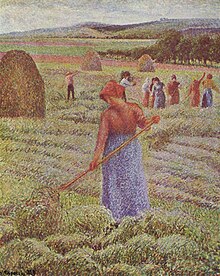
Reviews and adjustments[edit]
Rewald wrote that "the term 'Post-Impressionism' is not a very precise one, though a very convenient one"; convenient, when the term is by definition limited to French visual arts derived from Impressionism since 1886. Rewald's approach to historical data was narrative rather than analytic, and beyond this point he believed it would be sufficient to "let the sources speak for themselves."[10]
Rival terms likeModernismorSymbolismwere never as easy to handle, for they covered literature, architecture and other arts as well, and they expanded to other countries.
- Modernism,thus, is now considered to be the central movement withininternationalwestern civilization with its original roots in France, going back beyond theFrench Revolutionto theAge of Enlightenment.
- Symbolism,however, is considered to be a concept which emerged a century later in France, and implied an individual approach. Local national traditions as well as individual settings therefore could stand side by side, and from the very beginning a broad variety of artists practicing some kind of symbolic imagery, ranged between extreme positions:The Nabisfor example united to find synthesis of tradition and brand new form, while others kept to traditional, more or less academic forms, when they were looking for fresh contents: Symbolism is therefore often linked to fantastic, esoteric, erotic and other non-realist subject matter.
To meet the recent discussion, the connotations of the term 'Post-Impressionism' were challenged again:Alan Bownessand his collaborators expanded the period covered forward to 1914 and the beginning ofWorld War I,but limited their approach widely on the 1890s to France. Other European countries are pushed back to standard connotations, and Eastern Europe is completely excluded.
So, while a split may be seen between classical 'Impressionism' and 'Post-Impressionism' in 1886, the end and the extent of 'Post-Impressionism' remains under discussion. For Bowness and his contributors as well as for Rewald, 'Cubism' was an absolutely fresh start, and so Cubism has been seen in France since the beginning, and later in England. Meanwhile, Eastern European artists, however, did not care so much for western traditions, and proceeded to manners of painting calledabstractandsuprematic—terms expanding far into the 20th century.
According to the present state of discussion,Post-Impressionismis a term best used within Rewald's definition in a strictly historical manner, concentrating on French art between 1886 and 1914, and re-considering the altered positions ofimpressionistpainters likeClaude Monet,Camille Pissarro,Auguste Renoir,and others—as well as all new schools and movements at the turn of the century: fromCloisonnismtoCubism.The declarations of war, in July/August 1914, indicate probably far more than the beginning of aWorld War—they signal a major break in European cultural history, too.
Along with general art history information given about "Post-Impressionism" works, there are many museums that offer additional history, information and gallery works, both online and in house, that can help viewers understand a deeper meaning of "Post-Impressionism" in terms of fine art and traditional art applications.
Post-Impression in specific countries[edit]
The Advent of Modernism: Post-impressionism and North American Art, 1900-1918by Peter Morrin, Judith Zilczer, andWilliam C. Agee,the catalogue for an exhibition at theHigh Museum of Art,Atlanta in 1986, gave a major overview of Post-Impressionism in North America.
Canada[edit]
Canadian Post-Impressionismis an offshoot of Post-Impressionism.[11]In 1913, the Art Association of Montreal's Spring show included the work ofRandolph Hewton,A. Y. JacksonandJohn Lyman:it was reviewed with sharp criticism by theMontreal Daily Witnessand theMontreal Daily Star.[12]Post-Impressionism was extended to include a painting by Lyman, who had studied withMatisse.[13][14]Lyman wrote in defence of the term and defined it. He referred to the British show which he described as a great exhibition of modern art.[15]
Canadian artists and exhibitions[edit]
A wide and diverse variety of artists are called by this name in Canada. Among them areJames Wilson Morrice,[16]John Lyman,[17]David Milne,[18]andTom Thomson,[19]members of theGroup of Seven,[20]andEmily Carr.[21]In 2001, theRobert McLaughlin Galleryin Oshawa organized the travelling exhibitionThe Birth of the Modern: Post-Impressionism in Canada, 1900-1920.
Gallery of major Post-Impressionist artists[edit]
-
Odilon Redon(1840–1916)
-
Henri Rousseau(1844–1910)
-
Paul Gauguin(1848–1903)
-
Vincent van Gogh(1853–1890)
-
Charles Angrand(1854–1926)
-
Henri-Edmond Cross(1856–1910)
-
Maximilien Luce(1858–1941)
-
Georges Seurat(1859–1891)
-
Eugène Chigot(1860-1923)
-
René Schützenberger(1860–1916)
-
Marius Borgeaud(1861–1924)
-
Charles Laval(1862–1894)
-
Théo van Rysselberghe(1862–1926)
-
Paul Signac(1863–1935)
-
Henri de Toulouse-Lautrec(1864–1901)
-
Paul Sérusier(1864–1927)
-
Robert Deborne(1870–1944)
-
Paul Ranson(1864–1909)
-
Georges Lemmen(1865–1916)
-
Félix Vallotton(1865–1925)
-
Pierre Bonnard(1867–1947)
-
Édouard Vuillard(1868–1940)
-
Émile Bernard(1868–1941)
-
Maurice Denis(1870–1943)
-
Robert Antoine Pinchon(1886–1943)
See also[edit]
- Periods in Western art history
- Cubism
- Kapists
- Neo-impressionism
- Expressionism
- Fauvism
- History of painting
- Western painting
References and sources[edit]
References[edit]
- ^Metropolitan Museum of Art Timeline, Post-Impressionism
- ^abBrettell, Richard R.; Brettell, Richard (March 31, 1999).Modern Art, 1851-1929: Capitalism and Representation.Oxford University Press.ISBN9780192842206– via Google Books.
- ^abPeter Morrin, Judith Zilczer, William C. Agee,The Advent of Modernism. Post-Impressionism and North American Art, 1900-1918,High Museum of Art, 1986
- ^abBullen, J. B.Post-impressionists in England,p.37. Routledge, 1988.ISBN0-415-00216-8,ISBN978-0-415-00216-5
- ^Huyghe, Rene:Impressionism.(1973). Secaucus, N.J.: Chartwell Books Inc., p. 222.OCLC153804642
- ^Cogniat, Raymond (1975). Pissarro. New York: Crown, pp. 69–72.ISBN0-517-52477-5.
- ^ab"The Collection | MoMA".The Museum of Modern Art.
- ^Grafton Galleries, London (March 31, 1910)."Manet and the post-impressionists; Nov. 8th to Jan. 15th, 1910-11... (under revision)".London: Ballantyne – via Internet Archive.
- ^Gowing, Lawrence (2005).Facts on File Encyclopedia of Art:5. New York: Facts on File, p. 804.ISBN0-8160-5802-4
- ^abRewald, John:Post-Impressionism: From Van Gogh to Gauguin,revised edition: Secker & Warburg, London, 1978, p. 9.
- ^Murray, Joan (2001).The Birth of the Modern: Post-Impressionism in Canadian Art.Oshawa: Robert McLaughlin Gallery. p. 16.Retrieved25 July2022.
- ^Murray 2001,pp. 15–16.
- ^Lyman, John."Adieux, Matisse".Canadian Art.12(2 (Winter 1955)): 44–46.Retrieved2021-01-29.
- ^Murray 2001,pp. 143–144.
- ^Murray 2001,p. 16.
- ^Murray 2001,p. 117ff.
- ^Murray 2001,pp. 83–84, 143–144.
- ^Murray 2001,p. 111ff.
- ^Murray 2001,p. 133ff.
- ^Murray 2001,pp. 61ff, 78ff, 81ff etc..
- ^Murray 2001,p. 50ff.
Sources[edit]
- Bowness, Alan, et alt.:Post-Impressionism. Cross-Currents in European Painting,Royal Academy of Arts & Weidenfeld and Nicolson, London 1979ISBN0-297-77713-0
Further reading[edit]
- Manet and the Post-Impressionists(exh. cat. by R. Fry and D. MacCarthy, London, Grafton Gals, 1910–11)
- The Second Post-Impressionist Exhibition(exh. cat. by R. Fry, London, Grafton Gals, 1912)
- J. Rewald.Post-Impressionism: From Van Gogh to Gauguin(New York, 1956, rev. 3/1978)
- F. Elgar.The Post-Impressionists(Oxford, 1977)
- Post-Impressionism: Cross-currents in European Painting(exh. cat., ed. J. House and M. A. Stevens; London, RA, 1979–80)
- B. Thomson.The Post-Impressionists(Oxford and New York, 1983, rev. 2/1990)
- J. Rewald.Studies in Post-Impressionism(London, 1986)
- Beyond Impressionism,exhibit at Columbus Museum of Art, October 21, 2017 – January 21, 2018Beyond Impressionism Exhibition at Columbus Museum of Art
External links[edit]
- "Post-Impressionists",Walter Sickert's review inThe Fortnightly Reviewof the "Manet and the Post-Impressionists" exhibition at the Grafton Galleries
- "Post-Impressionism",Roger Fry's lecture on the closing of the "Manet and the Post-Impressionists" exhibition at the Grafton Galleries, as published inThe Fortnightly Review
- Georges Seurat, 1859–1891,a full text exhibition catalog from The Metropolitan Museum of Art
- Toulouse-Lautrec in the Metropolitan Museum of Art,a full text exhibition catalog from The Metropolitan Museum of Art
- "Roger Fry, Walter Sickert and Post-Impressionism at the Grafton Galleries",a reflection byMarnin Youngon the 1910–1911 exhibition





